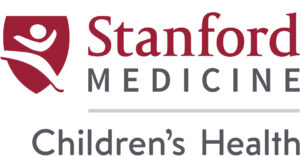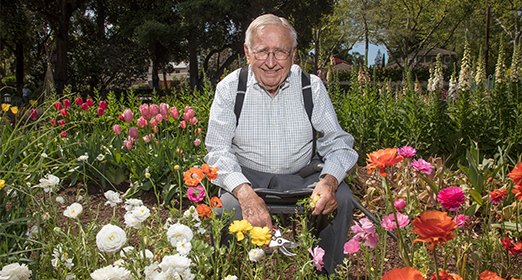Paul Althouse believes that if his great-grandnephew were born today with all our modern techniques, and not 20 years ago, he might still be alive. Shawn Charles Brown had a heart defect at birth and was less than a year old when surgeons in San Francisco operated. The procedure was unsuccessful, and unfortunately Shawn did not survive.
Saddened by the loss of Shawn, Althouse wanted to help other children diagnosed with difficult heart conditions and their families. Around that same time, he learned about Lucile Packard Children’s Hospital Stanford and its world-renowned pediatric cardiac surgery team. He decided to donate money he earned through a successful business and fruitful real estate investments to our hospital.
“I only owned two pieces of property. But anyone who bought real estate then and had it for as long as I did would look like a smart investor,” says the 91-year-old, with a chuckle.
Althouse came from somewhat modest beginnings, growing up on a 160-acre citrus orchard in the San Joaquin Valley with his parents and three siblings. Since orange trees take several years to bear fruit, the family first harvested row crops that grew alongside the citrus.
“Years later, you could walk through parts of the orchard and find asparagus growing,” says Althouse.
By the time he was in high school, the orchard was coming into its own, and Althouse’s interest in plants had firmly taken root. He went on to study botany at California State University, Fresno and then at the University of California, Davis. Instead of returning to the family business after graduating, he decided to move to the Bay Area.
“I was interested in plants, but I didn’t want any part of the orchard,” says Althouse. “I found this rundown dump of a nursery on El Camino Real in Redwood City. My father bought it for me, and I was there for 65 years.”
Redwood City Nursery grew into a local mainstay and was beloved by its many loyal customers. Althouse experienced a few bumps along the way, such as when his landlord announced that she was selling the property after he had operated his nursery on the site for 25 years. Fortunately, the half-acre lot next door was for sale, so he purchased it and simply relocated. Then 20 years later, Althouse handed over the business to his nephew so that he could eventually retire. Finally, in 2014 after 65 years, they both agreed to close the nursery and sell the land. It sold for a few million.
“I paid $130,000 when I bought the property,” says Althouse. “In those days, that was a lot of money.” By donating part of the proceeds from the sale to Packard Children’s, he reduced the taxes on the significant capital gains.
Leaving a Legacy
Over the years, Althouse has generously donated to our hospital in multiple ways that have enabled him to maximize his gifts and tax savings, including making qualified charitable distributions from his individual retirement account (IRA) and creating a charitable remainder trust (CRT).
Althouse created the CRT when he sold a four-unit apartment complex in Menlo Park in 2000. Through the CRT, Althouse receives a steady income, and when he passes away, 40 percent of the remaining assets will be gifted to Packard Children’s.
“Most other people would have children or grandchildren, which I don’t have,” says Althouse, who never married, explaining the reasons for his charitable giving. “I have nieces and nephews and grandnieces and grandnephews and even a couple of great-grandnephews, but they’re all taken care of in other ways.”
In honor of his great-grandnephew, Shawn, he created the Paul Althouse Endowment for Pediatric Cardiac Surgery at Packard Children’s. Althouse funnels additional money into the fund, which has grown to more than $750,000, through annual contributions from his IRA. Since it’s an endowed fund, the capital is reinvested and will remain in perpetuity.
Payouts from the interest support the work of famed pediatric cardiothoracic surgeon Frank Hanley, MD, and the Pediatric Cardiac Surgery Research Laboratory. Scientists in the lab perform basic research aimed at discovering ways to perform surgery more safely and to better understand the causes and solutions for cardiac disease in children.
“Generous support by individuals provides the resources for us to obtain the best equipment and hire the most talented scientists and surgeons,” says R. Kirk Riemer, PhD, director of the Pediatric Cardiac Surgery Research Laboratory. “With money from Paul’s endowment, we are conducting cutting-edge inquiries to find solutions that can be applied as soon as possible to help our young patients enjoy a full and fruitful life.”
Althouse also donates time and money to other causes he is passionate about. Still spry, he volunteers a few hours a day, four to five days a week, at the Elizabeth F. Gamble Garden in Palo Alto, where he maintains the cutting garden that provides fresh flower arrangements and displays throughout the historic house. Fellow volunteers planted a camellia with large, rich coral blooms in honor of his 90th birthday. The camellia is Althouse’s favorite flower.
In addition, Althouse is a volunteer gardener at the retirement community where he resides. He continues to enjoy attending performances of the San Francisco Opera and the San Francisco Symphony.
New Tax Laws and Smart Strategies for Charitable Giving in 2018
Ways to create a win-win for your finances and your favorite nonprofits
There are several ways to protect your financial future, save on taxes, and maximize your charitable donations. In 2018, changes to the tax law make charitable giving more attractive for individuals who land in higher tax brackets. Here’s what the changes might mean for you:
Donate Your IRA Distributions
Retirees over age 70½ can take advantage of the IRA rollover. You simply direct up to $100,000 of your required mini¬mum distribution from your IRA to your favorite charities instead. The distribution goes directly to the charity you designate and isn’t counted as part of your taxable income.
Reduce Capital Gains Tax
Capital gains are profits from the sale of an appreciated asset, such as stock, real estate, or a business, and generally are considered taxable. In 2018, capital gains tax rates increased, but donating these assets may help you reduce taxes and maximize your giving.
Instead of giving cash, you can donate securities such as stocks and bonds (held for more than one year) directly to a charity of your choice. Charities are tax-exempt, so you’ll reduce your capital gains tax and receive an income tax deduction based on the asset’s fair market value.
Next Steps
Before adopting any of these strategies, speak with a trusted financial advisor, attorney, or one of our Gift Planning experts at the Lucile Packard Foundation for Children’s Health.
You can reach: Jean Gorman, Director of Gift Planning, at Jean.Gorman@lpfch.org or (650) 736-1211.
This article originally appeared in the Spring 2018 issue of Packard Children’s News.
Photography credit: Douglas Peck



